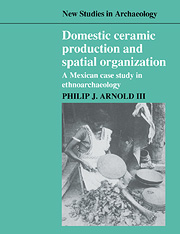Book contents
- Frontmatter
- Contents
- List of figures
- List of tables
- Acknowledgements
- 1 Introduction
- Part 1 Ceramic production and consumption in Los Tuxtlas
- Part 2 Ceramic production and spatial organization
- Part 3 Application and implication
- 8 Ceramic production organization in archaeological perspective
- 9 Conclusion
- References
- Index
9 - Conclusion
Published online by Cambridge University Press: 02 December 2009
- Frontmatter
- Contents
- List of figures
- List of tables
- Acknowledgements
- 1 Introduction
- Part 1 Ceramic production and consumption in Los Tuxtlas
- Part 2 Ceramic production and spatial organization
- Part 3 Application and implication
- 8 Ceramic production organization in archaeological perspective
- 9 Conclusion
- References
- Index
Summary
One of the more important advances stemming from the “essential polemics” (e.g. Dunnell 1986:25) of the last thirty years is the realization that archaeological materials are not self evident. Rather, it is the responsibility of the archaeologist to describe material patterns, identify meaningful variability, and interpret that variability. The current wealth of competing paradigms and programmatic statements is in one sense a tribute to archaeologists' increasing awareness of their role in generating inferences about the past (e.g. Watson 1986).
The theme of evaluating assumptions about the archaeological record has served as the centerpiece of the present work. If archaeologists wish to understand how ceramic production developed and integrated with prehispanic complex societies, research cannot simply focus on the archaeological record. Instead, studies dealing with contemporary production systems must be undertaken. Only in this way can both the behavior generating the pattern and the material consequences of that activity be controlled. It is the ability to document both cause and effect that enables archaeologists to establish the necessary relationships between pottery making and the material record.
For archaeologists interested in prehispanic ceramic production, the concept of actualistic research is nothing new. Anthropological accounts of contemporary potters have a long, established history (see Rice and Saffer 1982). The existing body of ethnoarchaeological information on pottery making is similarly impressive and continues to grow (e.g. Arnold 1987; Deal 1983; Hagstrum 1989; Kramer 1985). Furthermore, ethnographic accounts of ceramic production have recently been synthesized and presented in a systems perspective (Arnold 1985).
- Type
- Chapter
- Information
- Domestic Ceramic Production and Spatial OrganizationA Mexican Case Study in Ethnoarchaeology, pp. 152 - 163Publisher: Cambridge University PressPrint publication year: 1991



